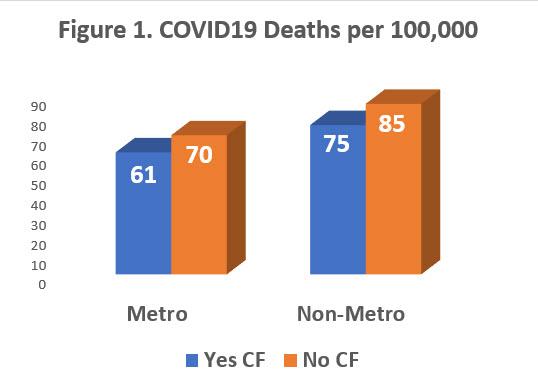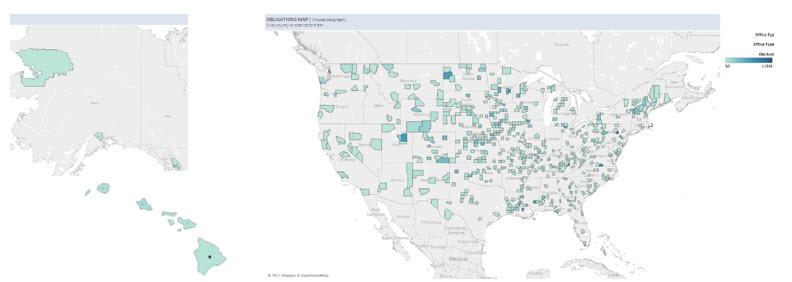Authors: Tamara Telles, MPH, Kellie Kubena, and Julia H. Cho, PhD
Introduction
The COVID-19 pandemic had a profound impact on the United States, with a death toll surpassing 540,000 by March 19, 2021, as noted at the time of the analysis in the article. Rural communities have faced unique challenges while also finding unique opportunities as a result of the pandemic. Limited access to care and aging populations increased vulnerability to COVID-19, while less dense population and distance from urban centers initially spared rural areas from the worst of COVID-19 impacts. Moving into the future, rural populations must think about how to manage community public health with some residents that cannot stay home when ill such as those in agriculture, food processing, or service jobs or where residents must travel farther for care especially elder or specialized care. Amid these challenges, the United States Department of Agriculture (USDA) has played a pivotal role in supporting rural America. The USDA's Rural Development (RD) mission area aims to enhance rural prosperity and the quality of life in rural America. One of the prominent programs is the Community Facilities (CF) Program, which has proven to be a valuable assistance for rural areas during the pandemic as it turned out to have prepared rural America for unforeseen healthcare calamity. The CF program focuses on financing community facilities and infrastructure development in rural areas, encompassing healthcare facilities and related services. As a result, USDA’s Rural Development Innovation Center and USDA’s Economic Research Service worked together to better understand how investment by USDA’s CF Program impacted the outcomes related to COVID-19 in rural communities.
The Vulnerabilities of Rural America
Rural areas have grappled with several factors that make them particularly vulnerable to the COVID-19 pandemic. These include an aging population, higher rates of underlying medical conditions, limited access to healthcare services, and greater distances to medical facilities when compared to more urban communities. Additionally, the lack of hospitals and healthcare infrastructure in many rural counties has exacerbated the crisis. Additionally, ongoing rural hospital closures and shortages of healthcare providers have exacerbated the impacts of both the pandemic and caring for those suffering from long-term impacts of COVID-19 or those who have suffered loss or isolation from the pandemic. Chartis Center for Rural Health (Topchik et al., 2020) looked at the rural hospital data from 2010 and claimed that more than 450 of the country’s rural hospitals are at risk of closing. The pandemic exposed long-standing healthcare and economic disparities in these regions, making it essential for the federal government to focus on rural policy. The Rural Partners Network initiative highlights how the federal government can focus on rural policy and assist rural communities directly to respond to challenges like the pandemic.
The Impact of the CF Program
Research by USDA staff, Anil Rupasingha and Julia Cho, has shown that counties receiving CF health funds demonstrated better COVID-19 outcomes, regardless of their rural or poverty status. Notably, nonmetropolitan counties that received CF health investments had 0.22 percentage points lower COVID-19-related deaths per case, translating to 220 fewer deaths per 100,000 cases (Fig. 1). This impact was even more significant in remote nonmetropolitan counties, with a 0.55 percentage point reduction, signifying 550 fewer deaths per 100,000 cases if the counties received the CF investments in the last 5 years up to the year 2020, when the COVID-19 Pandemic hit the United States extensively.

Conclusion
The Community Facilities Program provides grants and loans for essential infrastructure and facilities in rural areas. This includes healthcare clinics, hospitals, schools, fire and rescue stations, and more. Between 2016 and 2020, 508 counties received $3.6 billion in CF health-related investments, with a focus on communities with populations under 20,000 and low-income areas.

The USDA's Community Facilities Program has emerged as a crucial resource for addressing healthcare disparities in rural America, particularly during the COVID-19 pandemic. While more research is needed to understand the full extent of its impact, this program has undoubtedly been a lifeline for many rural communities. It underscores the importance of targeted initiatives in strengthening rural healthcare and addressing disparities during public health crises. Rural America is showing resilience coming out of the COVID-19 pandemic, thanks in part to the support provided by the USDA's CF Program.
For further information on the studies, please visit: https://www.choicesmagazine.org/choices-magazine/theme-articles/rural-development-implications-one-year-after-covid-19/usdas-community-facilities-program-may-help-rural-america-cope-with-covid-19
*CF Health Impact Analysis was conducted by USDA Rural Development Innovation Center’s Data Analytics Division. The findings and conclusions in this publication are those of the author(s) and should not be construed to represent any official USDA or U.S. government determination or policy.

